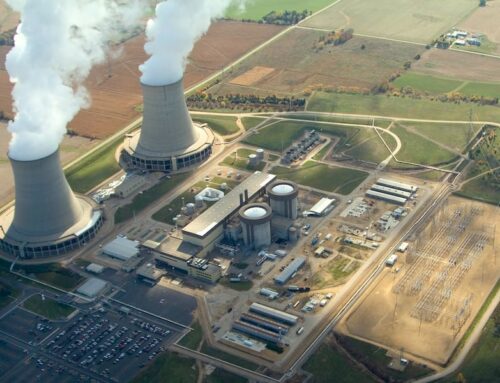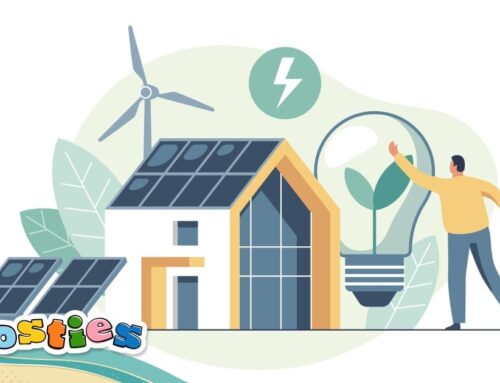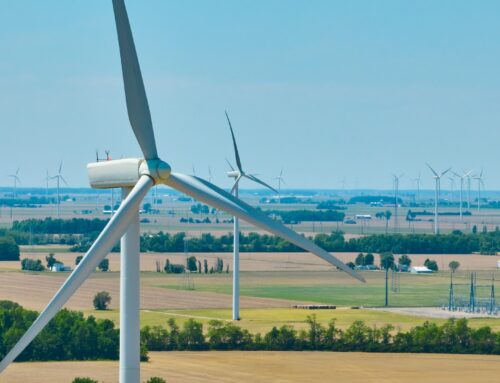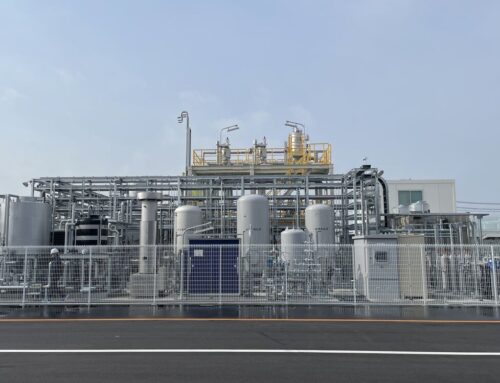In Colorado, a marriage of solar energy and farming provides a model for a more sustainable future
December 21, 2024
The fields surrounding Byron Kominek’s farm lay fallow. But on a sunny morning in mid-December, Kominek harvests the sun’s rays.
The idea to add solar panels to his family’s 24-acre farm emerged out of necessity.
“Without much farming experience, it’s hard to just jump into agriculture and expect to make a living on it. Solar was a way to have a long-term, steady income.” said Kominek, who moved to his grandfather’s farm in 2016 and now runs Jack’s Solar Garden — a nationally recognized site for agrivoltaic research named in honor of his grandfather.
Today, Kominek’s 3,276 solar panels generate enough electricity to power approximately 300 homes (the panels themselves take up just four acres of the property).
This year delivered Denver’s second hottest summer on record. As temperatures rise, agrivoltaics could provide a blueprint for how farmers can adapt.
Beneath the solar panels, ducks, geese and sheep graze, and workers tend to a variety of crops, including salad greens, corn and radishes — all of which have flourished in the partial shade of his solar panels.
As temperatures continue to rise, creating usable shade will become even more important.
“Having shade on the ground is a climate adaptation. I hate to say it, but I’ve kind of given up on the thought that we’re going to fix climate change whatsoever,” said Komenik. “Climate change is going to happen. It’s going to be rapid. It’s going to be terrible. So we need to figure out how to adapt to that changing climate.”
Traditional solar arrays are built low to the ground. They may help to meet clean energy targets, but they can have lasting negative impacts on the land, like soil compaction and habitat loss, and they often prohibit simultaneous uses of the land, such as growing food.
By raising solar panels eight feet, Kominek argues that solar companies open a world of opportunities below.
Growing crops or grazing animals in conjunction with solar can protect soil, provide landowners with an additional source of income and create valuable shade — which Kominek argues will become even more important to plants, animals and farm workers as temperatures rise.
At 42, Kominek’s resume includes a smattering of experience — from long distance motorcycle trips through western Africa to work in the Foreign Service and multiple engineering degrees. But it wasn’t until a few years ago that he tried his hand at growing food.
Kominek grew up in Johnson City, Tennessee, largely disconnected from agriculture. In the 1990s, he occasionally visited his family’s hay farm in Longmont, but by that time his grandfather had passed away and tenants farmed the fields.
While working as a natural resource officer in Zambia and Mozambique, Kominek
began to question the relationship many Americans had with the natural world.
“We don’t have to be extractive, it’s just how we’ve chosen to do it,” he said.
“Going to a different culture, different country, different context shows you that the same things that you do in your community can be achieved just by doing it differently.”

Cormac McCrimmon
/
Rocky Mountain PBS
Kominek moved to his family’s farm in 2016. Two years later, he took over the agricultural side of the property. From the start, he knew something needed to change.
“Property taxes were going up, our utilities were going up, everything was going up,” said Kominek.
Growing hay wasn’t going to cut it.
“The idea for solar came about as a means to have a passive income that could help make ends meet here on the land,” said Kominek.
Researchers at the National Renewable Energy Laboratory (NREL) and University of Arizona tipped him off to the emerging field of agrivoltaics — a portmanteau of agriculture and photovoltaics, which are more commonly known as solar panels.
“I liked the idea of keeping the land active,” he said.
Thanks to soaring property values in Boulder County, Kominek was able to put a lien on his farm to finance the construction of the solar panels. A series of lucky breaks followed: the farm sat across the street from a transmission line, the utility accepted his bid and the county changed its land use code to allow the project.
Today, Kominek estimates that he earns $20,000 annually by selling energy to subscribers.

Cormac McCrimmon
/
Rocky Mountain PBS
Industry experts value Colorado’s solar market at $8.1 billion. In 2023 alone, investors poured $2.3 billion into solar. Unfortunately, Kominek argues that the current evaluation system for large-scale solar projects could cost communities in the long run.
“Oftentimes how [communities] evaluate bids from solar companies has nothing to do with land stewardship, has nothing to do with the agricultural activities or what goes on there. It really focuses on the price per kilowatt hour and whether they’ve done a project before or not,” said Kominek.
Without further regard for land stewardship, large-scale projects can quickly turn into “a race to the bottom,” he said.
“Does the community want the cheapest power possible at the expense of our lands? That’s a big question,” said Kominek.
In order to make way for solar arrays, utility companies typically grade the land, which compacts soil.
“Compaction is the enemy of all vegetation,” said Komenik.
Once land is compacted, it can be difficult to revive since tilling can further degrade the soil and its ability to retain water.

Cormac McCrimmon
/
Rocky mountain PBS
Perhaps a bigger problem, however, is that the status quo doesn’t incentivize agrivoltaics.
According to Komenik, rules for solar development vary widely county by county. Even communities that welcome solar projects often don’t request stipulations for agriculture.
According to Komenik, utility companies fear animals could damage solar arrays and that vegetation could interfere with energy capture.
“The solar industry sees all vegetation as the enemy. If it grows too tall, they think it will shade the panels,” he said.
Since the panels need to be elevated, the costs of agrivoltaics are higher than traditional solar arrays. Komenik thinks the price is overblown.
“A lot of the cost of the solar array is the people — installing the solar panels and all the wiring that goes into it. Inverters and the transformers and the switchgear. None of that changes,” he said.
NREL estimates that agrivoltaic systems cost between $0.07 and $0.80 more per watt of direct current.
Komenik understands that agrivoltaics’ long-term future is dependent on community buy-in. That’s why he dedicates a lot of his time to education.
“We need more examples. If there’s just one in the country, it’s easy to dismiss, but when there’s thousands of them, people are more able to go out, learn about it, and figure out how they can do it,” he said.
In Delta County, construction is underway at the Garnet Mesa solar project, an 80 megawatt agrivoltaic project that will provide power to approximately 18,000 homes and forage to approximately 600 sheep. Once built, it will become the state’s largest irrigated agrivoltaic site.
County Commissioner Wendell Koontz was skeptical when the project first came across his desk.
After a lifetime working in the energy industry, Koontz saw the plan’s lack of provisions for reclamation and irrigation as red flags.
“Solar developers need to be held to the same economic and environmental standards that we would hold oil and gas, coal, any other energy provider to,” said Koontz.
Koontz and fellow county commissioners gave their approval once developers revised the plan to add irrigation, changes to fences and landscaping and bonding for site reclamation.
Once “I put my name on the resolution approving this project I got a stake in the game. Now I don’t want to see it fail,” he said.
Although elevated panels may provide sufficient room for people and sheep, they complicate mechanized agriculture. Koontz worries that noxious weeds or pooling water could become a problem if the irrigated land isn’t properly managed.
Among the people he represents in Delta County, Koontz said that many would prefer to keep irrigated lands separate and relegate solar to barren mineral lands.
“The ag economy is what really drives Delta County. It’s part of our heritage. It’s part of our culture,” said Kootnz. “We’ve got to be very thoughtful about what we’re doing here because this is about food and economies.”
Koontz said he’s “cautiously optimistic,” about the future of agrivoltaics. But after seeing how difficult these projects are to complete, he’s highly skeptical of the state’s promise to have 100% renewable energy by 2040.

Cormac McCrimmon
/
Rocky Mountain PBS
During the growing season, Jack’s Solar Farm buzzes with activity. Workers from Sprout City Farms, a Denver nonprofit, cultivate vegetables to sell at local farmers markets and donate to food pantries. The rest of the space is divided among researchers from Colorado State University, the University of Arizona and NREL.
Although Komenik said that certain squash and beets haven’t fared well in the partial shade of his solar panels, most species have thrived.
“Colorado is not a light-limited state. We’re a water limited state. A lot of the little seed packets that we get come from the East Coast, where they have cloud cover and rain and such. We don’t have those things out here,” said Komenick.
Solar panels that rotate throughout the day provide partial sunlight akin to a sky of rolling clouds.
On the hottest days, Komenik estimates that the shade beneath his panels is 15 to 20 degrees cooler than areas in direct sun. Working in the shade isn’t just a boon to workers who tend the property’s vegetables, it also helps to save water.
Despite the success of Komenik’s operation, he thinks that future agrivoltaic development can take many forms. His farm’s proximity to Longmont, high quality soil and small footprint favored market vegetables and small-scale grazing.
In all likelihood, future solar projects are likely to unfold on grasslands, where developers can get the most bang for their buck.
“The majority of large solar arrays are being built in communities that have less than a few thousand people anywhere near them and so you don’t have as much labor as is required for this type of work,” said Komenik.
In these areas, sheep and cattle grazing offer an additional way to use the land that is less labor intensive and a better fit for the environment.
Regardless of location, the number one key to success is a willingness to adapt.
“If you’re expecting to do the exact same thing as you were before the solar panels, you’re going to be in for a surprise,” said Komenik.
“It is going to change. It doesn’t mean that it will necessarily be worse. It will simply be different.”
Copyright 2024 Rocky Mountain PBS.
This story fromRocky Mountain PBSwas shared via Rocky Mountain Community Radio, a network of public media stations in Colorado, Wyoming, Utah and New Mexico including Aspen Public Radio.
Search
RECENT PRESS RELEASES
Related Post




